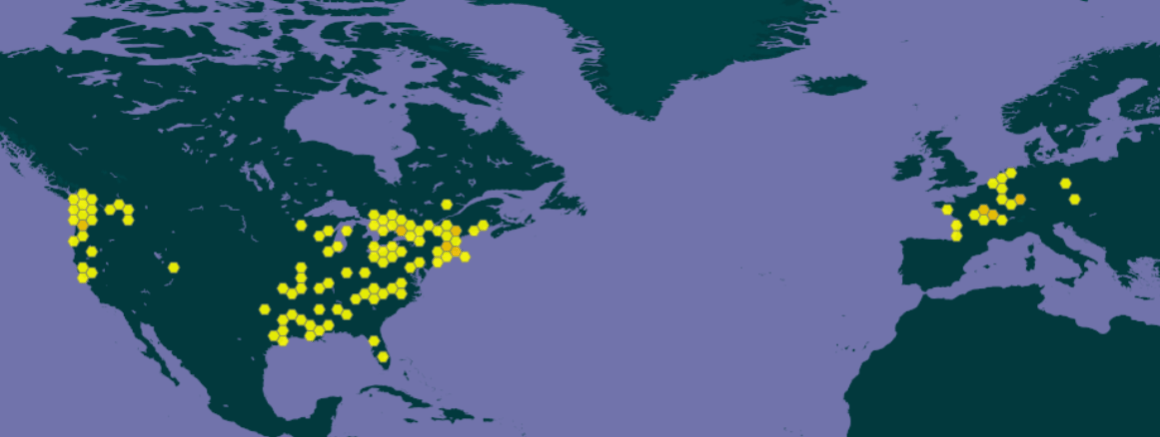 |
Magnificent bryozoan | Status LU: established. 1st record: ~2011. |
 |
Schwamp-Moosdéierchen | Status Eur.: established. |
 |
Pectinatelle | RA: ISEIA: C1. Harmonia+: n/a. |
 |
Schwammartiges Moostierchen | Wikipedia:     | Wikispecies: | Wikispecies:  |
 |
n/a | Back to the list of invertebrates |
Contents
Report the species
→ Report Pectinatella magnifica to the National Museum of Natural History.
Brief description
 Pectinatella magnifica, the magnificent bryozoan, is a member of the Bryozoa phylum, in the order Plumatellida. It is a colony of organisms that bind together; these colonies can sometimes be 60 centimeters in diameter. These organisms can be found mostly in North America with some in Europe. They are often found attached to objects, but can be found free floating as well. They form a translucent body with many star-like blooms along the outside. The density of the organism is similar to that of gelatin, and is easily breakable into smaller chunks (Wikipedia contributors 2018).
Pectinatella magnifica, the magnificent bryozoan, is a member of the Bryozoa phylum, in the order Plumatellida. It is a colony of organisms that bind together; these colonies can sometimes be 60 centimeters in diameter. These organisms can be found mostly in North America with some in Europe. They are often found attached to objects, but can be found free floating as well. They form a translucent body with many star-like blooms along the outside. The density of the organism is similar to that of gelatin, and is easily breakable into smaller chunks (Wikipedia contributors 2018).
Status and distribution in Luxembourg
Records of Pectinatella magnifica (Leidy, 1851) in Luxembourg. Data source: Recorder-Lux, iNaturalist & GBIF, 2025-07-04.
In 2012 numerous colonies of Pectinatella magnifica (Leidy, 1851) (Bryozoa, Phylactolaemata) were discovered in the reservoir of Esch-sur-Sûre (Luxembourg) fed by the river Sûre. The colonies were particularly abundant in the shallow, warm and nutrient-rich water near the riverbank, but some colonies were spotted by divers in the reservoir at a depth of 8-9 m in one site and more than 20 m in another site. There is reliable evidence that Pectinatella was present, but less conspicuous and as such not identified, in 2011 and possibly already in 2010. P. magnifica was hitherto unrecorded in Luxembourg, but known from a site near the German-Luxembourg border near Nennig (Germany, Saarland) where statoblasts were found in 2001 (Massard et al. 2013).
Risk assessment
ISEIA protocol
C1 (3+2+1+1) (Ries et al. 2017: 68).
Harmonia+ protocol
Not assessed yet.
Worldwide distribution
Bibliography
- GBIF, 2019. Pectinatella magnifica (Leidy, 1851) in GBIF Secretariat (2019). GBIF Backbone Taxonomy. Checklist dataset https://doi.org/10.15468/39omei [accessed 2020-03-13]
- Massard, J.A., G. Geimer & E. Wille, 2013. Apparition de Pectinella magnifica (Leidy, 1851) (Bryozoa, Phylactolaemata) dans le lac de barrage d’Esch-sur-Sûre (Luxembourg). Bulletin de la Société des naturalistes luxembourgeois 114: 131-148.
- Massard, J.A. & G. Geimer, 2015. L’histoire de la recherche bryozoologique au Luxembourg (Phylactolémates et Gymnolémates deau douce). Bull. Soc. Nat. luxemb. 116: 373-379. [PDF 1,35 MB]
- MNHNL, iNaturalist & GBIF, 2021. MNHNL-mdata, online portal combining species observation from Recorder-Lux, iNaturalist and GBIF. National Museum of Natural History, Luxembourg. URL: https://mdata.mnhn.lu [Accessed 2021-04-14]
- Ries, C., A. Arendt, C. Braunert, S. Christian, A. Dohet, A. Frantz, G. Geimer, M. Hellers, J. A. Massard, X. Mestdagh, R. Proess, N. Schneider & M. Pfeiffenschneider, 2017. Environmental impact assessment and black, watch and alert list classification after the ISEIA Protocol of invertebrates in Luxembourg. Bull. Soc. Nat. luxemb. 119: 63-70. [PDF 360 KB]
- Wikipedia contributors, 2018. ‘Pectinatella magnifica’, Wikipedia, The Free Encyclopedia, 3 December 2018, 23:25 UTC, <https://en.wikipedia.org/w/index.php?title=Pectinatella_magnifica&oldid=871869936> [accessed 2020-03-13]
Suggested citation of this webpage
Ries, C. & M. Pfeiffenschneider (Eds.), 2025. Pectinatella magnifica (Leidy, 1851). In: neobiota.lu - Invasive Alien Species in Luxembourg. National Museum of Natural History, Luxembourg. URL: https://neobiota.lu/pectinatella-magnifica/ [Accessed 2025-07-04].
Page content last updated on 2023-08-21. Last proofread by Caroline Grounds on 2019-11-12.


